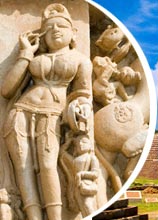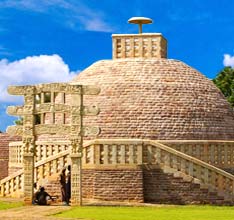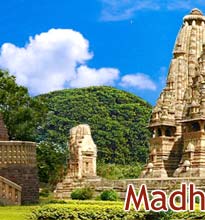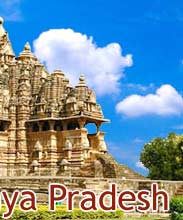 Washed
by the holy waters of the Narmada River and encompassed by rocky
hummocks of all sizes, Jabalpur is considered as one of the most
important cities in Madhya Pradesh. Owing to its hilly terrain, the
place is also known as the "The City of the Rocks". An
erstwhile capital of the medieval Gond rulers, during the 12th century,
and the capital of the Kalchuri Kings and the Marathas, Jabalpur was
later appropriated by the British. The historical diversity and the
scenic singularity of the place make it a unique tourist destination.
This article spells out the tourist attractions in Jabalpur i.e. the
places that are of interest to tourists and should be seen on a city
tour.
Washed
by the holy waters of the Narmada River and encompassed by rocky
hummocks of all sizes, Jabalpur is considered as one of the most
important cities in Madhya Pradesh. Owing to its hilly terrain, the
place is also known as the "The City of the Rocks". An
erstwhile capital of the medieval Gond rulers, during the 12th century,
and the capital of the Kalchuri Kings and the Marathas, Jabalpur was
later appropriated by the British. The historical diversity and the
scenic singularity of the place make it a unique tourist destination.
This article spells out the tourist attractions in Jabalpur i.e. the
places that are of interest to tourists and should be seen on a city
tour.Madan Mahal Fort
This 900 year old fort dominates the skyline of Jabalpur. Built by the Gond king, Madan Shah in the year 1116, it rests atop a rocky cliff. Madan Mahal Fort offers some enthralling views of the low-lying vistas below. Atypical of ancient forts, this edifice does not display any ornamental artwork or sculptured embellishments. It is the sheer simplicity of the fort that overwhelms one with a sense of calm and makes it worth a visit.
Rani Durgavati Memorial and Museum
Built in the year 1964, to commemorate Queen Durgavati, Rani Durgavati Memorial and Museum is a storehouse of various treasured relics. The museum is home to precious miscellanies like ancient sculptures and rare manuscripts. Antique idols of Gods and Goddesses that dates back to the 10th century are also preserved in the place. A section of the museum is completely set aside, to store objects and artifacts related to the life of Mahatma Gandhi.
Pisan Hari Jain Temples/ Pisan Hari Ka Mandir
This cluster of ancient Jain temples, believed to be nearly 150 years old, is set atop a hillock, 7 km from the city of Jabalpur. Located near the Netaji Subhash Chandra Bose Medical College, these temples owe their name to a poor lady. The word 'Pisan' in Hindi means 'to grind'. It is believed that the lady initiated the construction of the temples, with the money earned from milling flour. Today, the temples form a major tourist attraction of Jabalpur, mainly because of their beauty and religious connotation.
Sangram Sagar and Bajnamath
These medieval constructions were erected under the imperial regime of the famous Gond King, Sangram Shah. Built in a time span that stretches from 1480 to 1540, these ancient buildings stand at a distance of 15 km from the main city of Jabalpur. Their imposing stance is worth a sight. Aquatic birds like red crested pochards, coots and pin-tailed ducks waddle in the nearby Sangram Sagar Lake and add to the attraction of the place.
Chausat Yogini Temple
Positioned at the top of a hill and approached by a long stairway, Chausat Yogini Temple is dedicated to Goddess Durga. The temple, with its elevated location, offers some breathtaking views of the Narmada River and the marble-crowned landscape. This 10th century temple has deftly carved stone idols of Hindu deities, belonging to the Kalchuri period. According to legends, it has a secret underground passageway that links to Queen Durgavati's palace.
Tilwara Ghat
Located 12 km from the Jabalpur Railway Station, Tilwara Ghat is one of the places from where Mahatma Gandhi's ashes were immersed. It sites on the holy bank of the Narmada and is famous for being the venue of the open session of the Tripuri Congress in 1939. An ancient Mahadev temple (Tilwadeshwar) is located here and draws many visitors to the place. Some of its nearby attractions include Mala Devi Mandir, Pariyat Tank, Bargi Dam, Lamheta Ghat and Roopnath Lingam.










